Research on Stakeholder Support Impact on FMCG Brand Equity
VerifiedAdded on 2023/06/12
|12
|2478
|283
Report
AI Summary
This report explores the significant role of stakeholder support on the brand equity of Fast Moving Consumer Goods (FMCG) companies, particularly multinational corporations like Unilever. It investigates how stakeholders, including governments, consumers, suppliers, and competitors, influence brand equity and revenue generation. The research aims to study the relationship between stakeholder support and brand equity, exploring how stakeholders contribute to the success or failure of FMCG brands. Key research questions focus on the impact of stakeholders on brand equity and the role of customer satisfaction in strengthening it. The methodology includes a combination of descriptive, explanatory, and expository research designs, employing post-positivism philosophy and both deductive and inductive approaches. Data collection involves primary methods like surveys and interviews, alongside secondary data from articles, journals, and websites. The findings from this research are intended to provide valuable insights for future studies on brand equity and assist multinational companies in enhancing their revenue generation strategies.
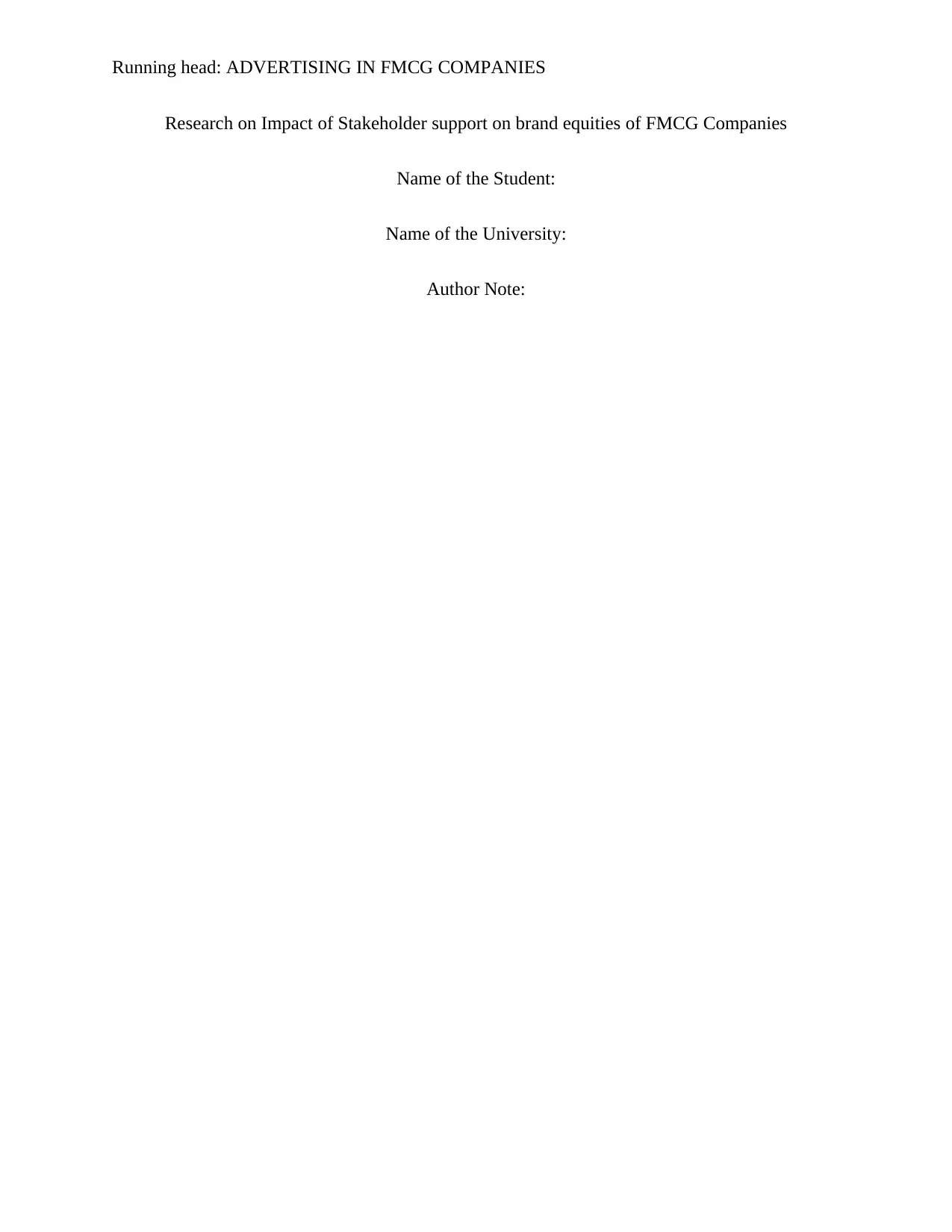
Running head: ADVERTISING IN FMCG COMPANIES
Research on Impact of Stakeholder support on brand equities of FMCG Companies
Name of the Student:
Name of the University:
Author Note:
Research on Impact of Stakeholder support on brand equities of FMCG Companies
Name of the Student:
Name of the University:
Author Note:
Paraphrase This Document
Need a fresh take? Get an instant paraphrase of this document with our AI Paraphraser
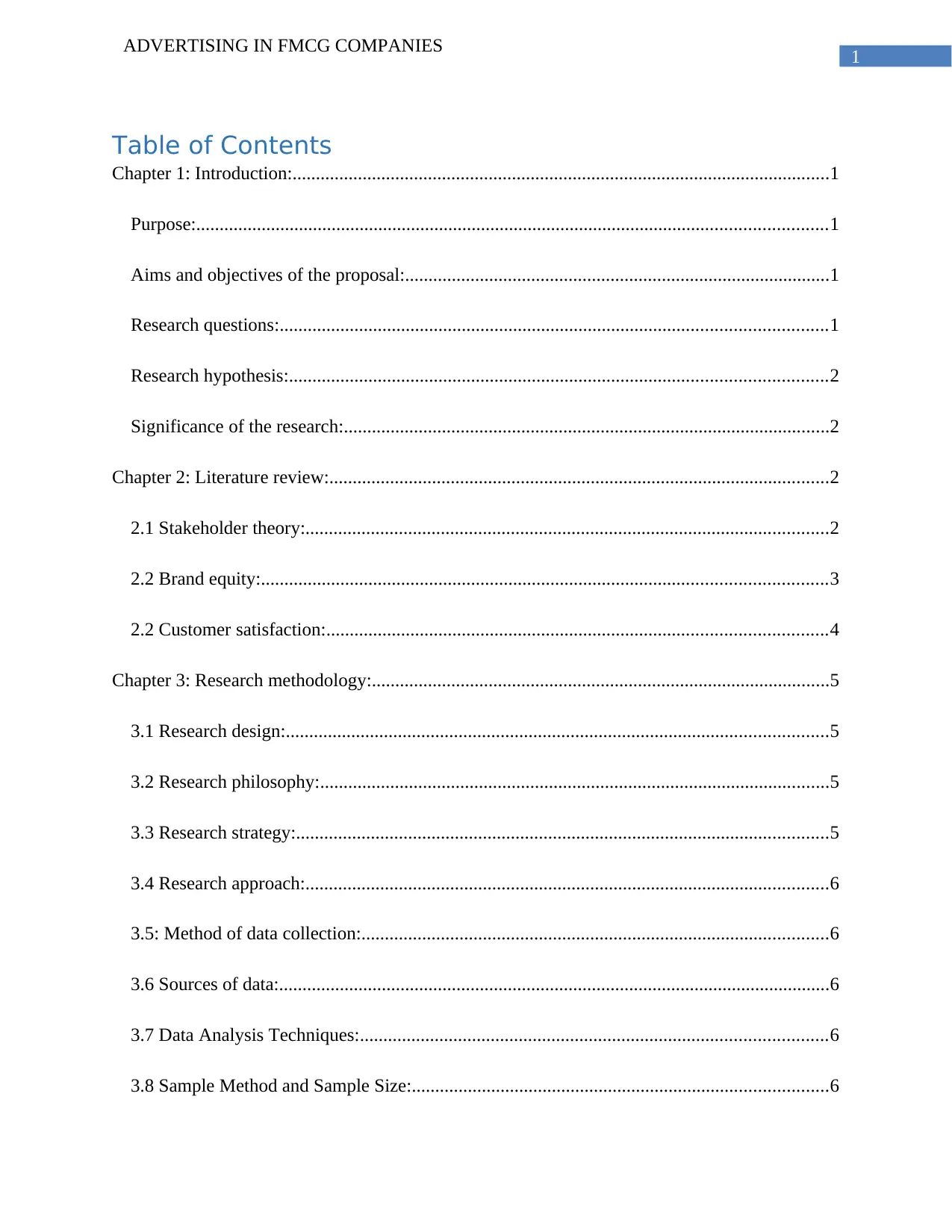
1
ADVERTISING IN FMCG COMPANIES
Table of Contents
Chapter 1: Introduction:...................................................................................................................1
Purpose:.......................................................................................................................................1
Aims and objectives of the proposal:...........................................................................................1
Research questions:.....................................................................................................................1
Research hypothesis:...................................................................................................................2
Significance of the research:........................................................................................................2
Chapter 2: Literature review:...........................................................................................................2
2.1 Stakeholder theory:................................................................................................................2
2.2 Brand equity:.........................................................................................................................3
2.2 Customer satisfaction:...........................................................................................................4
Chapter 3: Research methodology:..................................................................................................5
3.1 Research design:....................................................................................................................5
3.2 Research philosophy:.............................................................................................................5
3.3 Research strategy:..................................................................................................................5
3.4 Research approach:................................................................................................................6
3.5: Method of data collection:....................................................................................................6
3.6 Sources of data:......................................................................................................................6
3.7 Data Analysis Techniques:....................................................................................................6
3.8 Sample Method and Sample Size:.........................................................................................6
ADVERTISING IN FMCG COMPANIES
Table of Contents
Chapter 1: Introduction:...................................................................................................................1
Purpose:.......................................................................................................................................1
Aims and objectives of the proposal:...........................................................................................1
Research questions:.....................................................................................................................1
Research hypothesis:...................................................................................................................2
Significance of the research:........................................................................................................2
Chapter 2: Literature review:...........................................................................................................2
2.1 Stakeholder theory:................................................................................................................2
2.2 Brand equity:.........................................................................................................................3
2.2 Customer satisfaction:...........................................................................................................4
Chapter 3: Research methodology:..................................................................................................5
3.1 Research design:....................................................................................................................5
3.2 Research philosophy:.............................................................................................................5
3.3 Research strategy:..................................................................................................................5
3.4 Research approach:................................................................................................................6
3.5: Method of data collection:....................................................................................................6
3.6 Sources of data:......................................................................................................................6
3.7 Data Analysis Techniques:....................................................................................................6
3.8 Sample Method and Sample Size:.........................................................................................6

2
ADVERTISING IN FMCG COMPANIES
3.9 Ethical Consideration:...........................................................................................................6
3.10 Gantt Chart:.........................................................................................................................7
References:......................................................................................................................................8
ADVERTISING IN FMCG COMPANIES
3.9 Ethical Consideration:...........................................................................................................6
3.10 Gantt Chart:.........................................................................................................................7
References:......................................................................................................................................8
⊘ This is a preview!⊘
Do you want full access?
Subscribe today to unlock all pages.

Trusted by 1+ million students worldwide
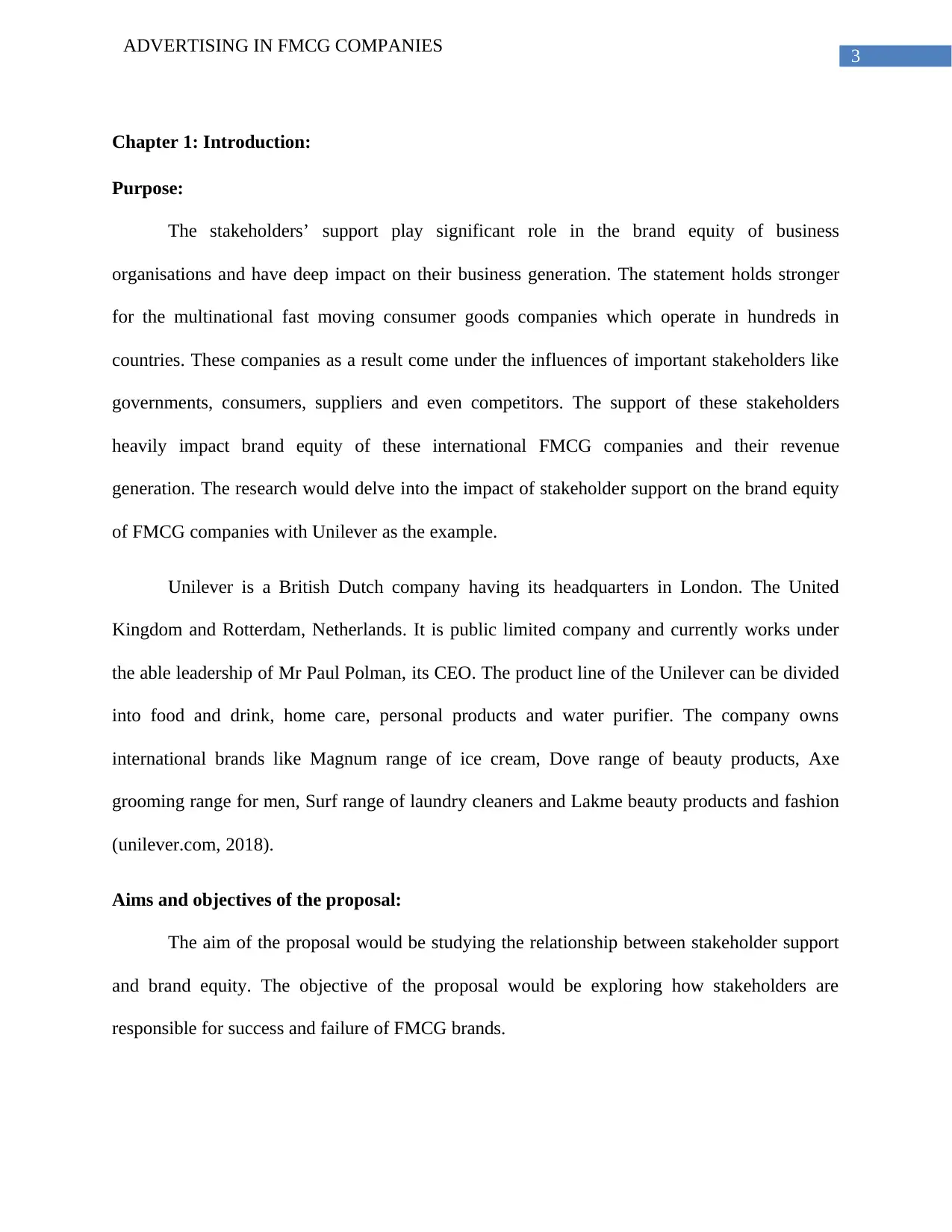
3
ADVERTISING IN FMCG COMPANIES
Chapter 1: Introduction:
Purpose:
The stakeholders’ support play significant role in the brand equity of business
organisations and have deep impact on their business generation. The statement holds stronger
for the multinational fast moving consumer goods companies which operate in hundreds in
countries. These companies as a result come under the influences of important stakeholders like
governments, consumers, suppliers and even competitors. The support of these stakeholders
heavily impact brand equity of these international FMCG companies and their revenue
generation. The research would delve into the impact of stakeholder support on the brand equity
of FMCG companies with Unilever as the example.
Unilever is a British Dutch company having its headquarters in London. The United
Kingdom and Rotterdam, Netherlands. It is public limited company and currently works under
the able leadership of Mr Paul Polman, its CEO. The product line of the Unilever can be divided
into food and drink, home care, personal products and water purifier. The company owns
international brands like Magnum range of ice cream, Dove range of beauty products, Axe
grooming range for men, Surf range of laundry cleaners and Lakme beauty products and fashion
(unilever.com, 2018).
Aims and objectives of the proposal:
The aim of the proposal would be studying the relationship between stakeholder support
and brand equity. The objective of the proposal would be exploring how stakeholders are
responsible for success and failure of FMCG brands.
ADVERTISING IN FMCG COMPANIES
Chapter 1: Introduction:
Purpose:
The stakeholders’ support play significant role in the brand equity of business
organisations and have deep impact on their business generation. The statement holds stronger
for the multinational fast moving consumer goods companies which operate in hundreds in
countries. These companies as a result come under the influences of important stakeholders like
governments, consumers, suppliers and even competitors. The support of these stakeholders
heavily impact brand equity of these international FMCG companies and their revenue
generation. The research would delve into the impact of stakeholder support on the brand equity
of FMCG companies with Unilever as the example.
Unilever is a British Dutch company having its headquarters in London. The United
Kingdom and Rotterdam, Netherlands. It is public limited company and currently works under
the able leadership of Mr Paul Polman, its CEO. The product line of the Unilever can be divided
into food and drink, home care, personal products and water purifier. The company owns
international brands like Magnum range of ice cream, Dove range of beauty products, Axe
grooming range for men, Surf range of laundry cleaners and Lakme beauty products and fashion
(unilever.com, 2018).
Aims and objectives of the proposal:
The aim of the proposal would be studying the relationship between stakeholder support
and brand equity. The objective of the proposal would be exploring how stakeholders are
responsible for success and failure of FMCG brands.
Paraphrase This Document
Need a fresh take? Get an instant paraphrase of this document with our AI Paraphraser
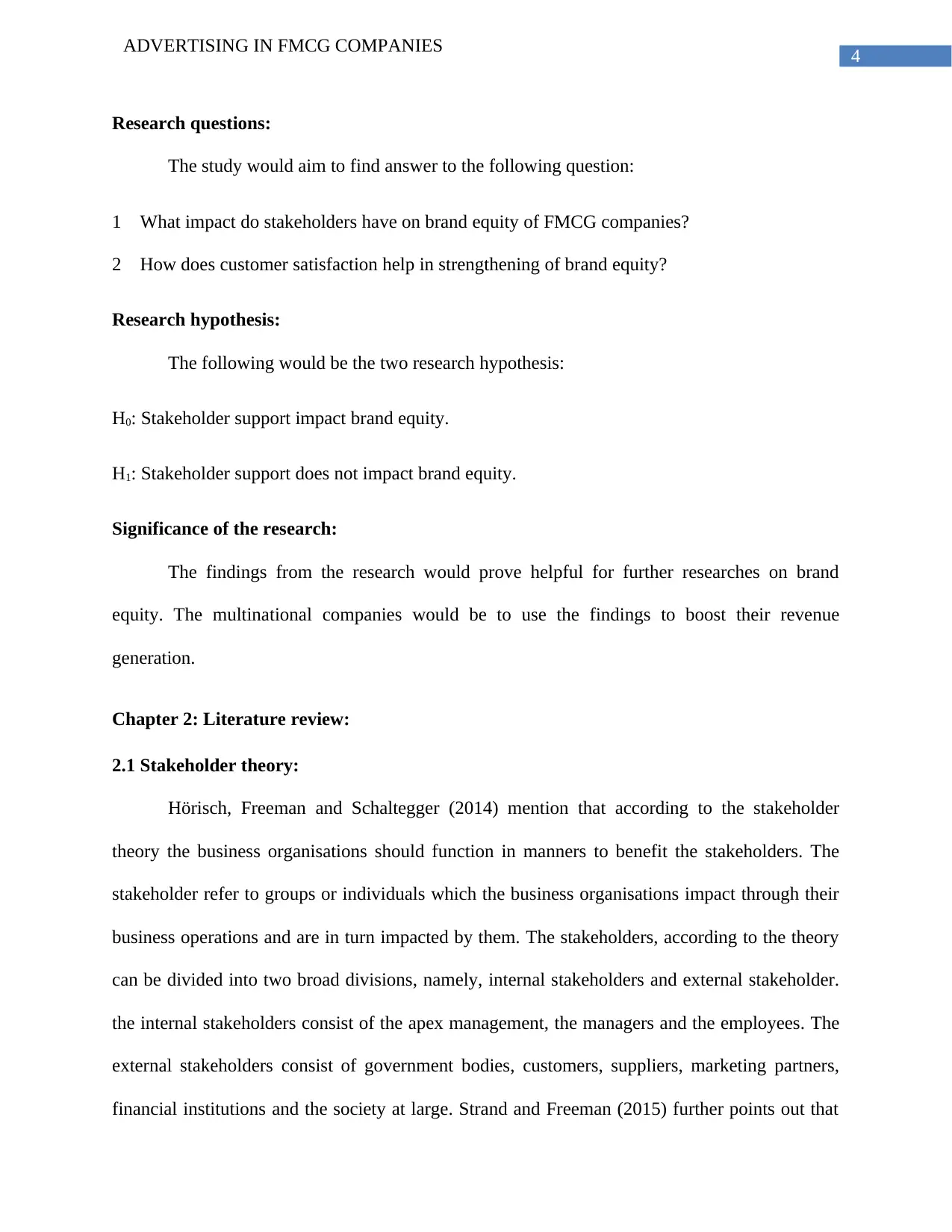
4
ADVERTISING IN FMCG COMPANIES
Research questions:
The study would aim to find answer to the following question:
1 What impact do stakeholders have on brand equity of FMCG companies?
2 How does customer satisfaction help in strengthening of brand equity?
Research hypothesis:
The following would be the two research hypothesis:
H0: Stakeholder support impact brand equity.
H1: Stakeholder support does not impact brand equity.
Significance of the research:
The findings from the research would prove helpful for further researches on brand
equity. The multinational companies would be to use the findings to boost their revenue
generation.
Chapter 2: Literature review:
2.1 Stakeholder theory:
Hörisch, Freeman and Schaltegger (2014) mention that according to the stakeholder
theory the business organisations should function in manners to benefit the stakeholders. The
stakeholder refer to groups or individuals which the business organisations impact through their
business operations and are in turn impacted by them. The stakeholders, according to the theory
can be divided into two broad divisions, namely, internal stakeholders and external stakeholder.
the internal stakeholders consist of the apex management, the managers and the employees. The
external stakeholders consist of government bodies, customers, suppliers, marketing partners,
financial institutions and the society at large. Strand and Freeman (2015) further points out that
ADVERTISING IN FMCG COMPANIES
Research questions:
The study would aim to find answer to the following question:
1 What impact do stakeholders have on brand equity of FMCG companies?
2 How does customer satisfaction help in strengthening of brand equity?
Research hypothesis:
The following would be the two research hypothesis:
H0: Stakeholder support impact brand equity.
H1: Stakeholder support does not impact brand equity.
Significance of the research:
The findings from the research would prove helpful for further researches on brand
equity. The multinational companies would be to use the findings to boost their revenue
generation.
Chapter 2: Literature review:
2.1 Stakeholder theory:
Hörisch, Freeman and Schaltegger (2014) mention that according to the stakeholder
theory the business organisations should function in manners to benefit the stakeholders. The
stakeholder refer to groups or individuals which the business organisations impact through their
business operations and are in turn impacted by them. The stakeholders, according to the theory
can be divided into two broad divisions, namely, internal stakeholders and external stakeholder.
the internal stakeholders consist of the apex management, the managers and the employees. The
external stakeholders consist of government bodies, customers, suppliers, marketing partners,
financial institutions and the society at large. Strand and Freeman (2015) further points out that
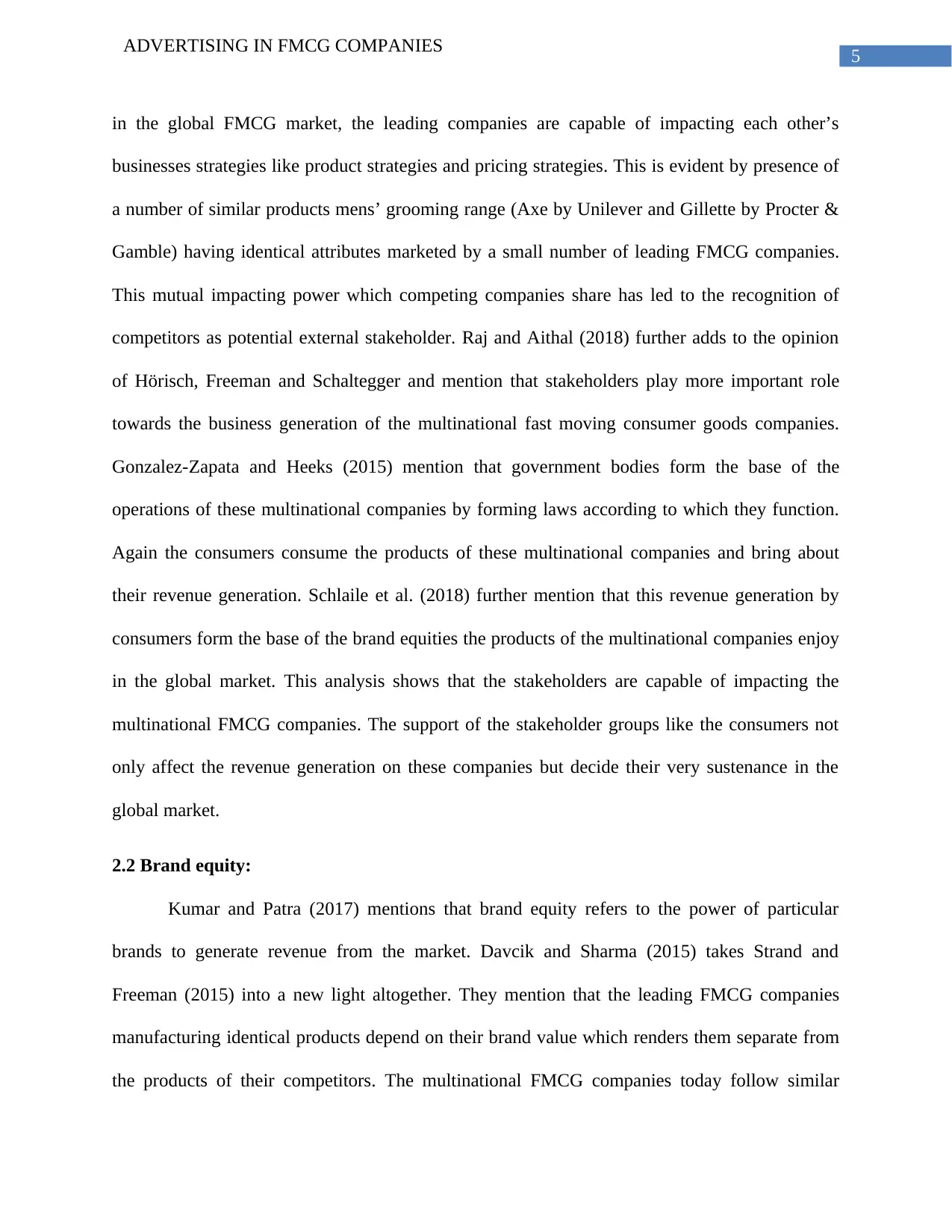
5
ADVERTISING IN FMCG COMPANIES
in the global FMCG market, the leading companies are capable of impacting each other’s
businesses strategies like product strategies and pricing strategies. This is evident by presence of
a number of similar products mens’ grooming range (Axe by Unilever and Gillette by Procter &
Gamble) having identical attributes marketed by a small number of leading FMCG companies.
This mutual impacting power which competing companies share has led to the recognition of
competitors as potential external stakeholder. Raj and Aithal (2018) further adds to the opinion
of Hörisch, Freeman and Schaltegger and mention that stakeholders play more important role
towards the business generation of the multinational fast moving consumer goods companies.
Gonzalez-Zapata and Heeks (2015) mention that government bodies form the base of the
operations of these multinational companies by forming laws according to which they function.
Again the consumers consume the products of these multinational companies and bring about
their revenue generation. Schlaile et al. (2018) further mention that this revenue generation by
consumers form the base of the brand equities the products of the multinational companies enjoy
in the global market. This analysis shows that the stakeholders are capable of impacting the
multinational FMCG companies. The support of the stakeholder groups like the consumers not
only affect the revenue generation on these companies but decide their very sustenance in the
global market.
2.2 Brand equity:
Kumar and Patra (2017) mentions that brand equity refers to the power of particular
brands to generate revenue from the market. Davcik and Sharma (2015) takes Strand and
Freeman (2015) into a new light altogether. They mention that the leading FMCG companies
manufacturing identical products depend on their brand value which renders them separate from
the products of their competitors. The multinational FMCG companies today follow similar
ADVERTISING IN FMCG COMPANIES
in the global FMCG market, the leading companies are capable of impacting each other’s
businesses strategies like product strategies and pricing strategies. This is evident by presence of
a number of similar products mens’ grooming range (Axe by Unilever and Gillette by Procter &
Gamble) having identical attributes marketed by a small number of leading FMCG companies.
This mutual impacting power which competing companies share has led to the recognition of
competitors as potential external stakeholder. Raj and Aithal (2018) further adds to the opinion
of Hörisch, Freeman and Schaltegger and mention that stakeholders play more important role
towards the business generation of the multinational fast moving consumer goods companies.
Gonzalez-Zapata and Heeks (2015) mention that government bodies form the base of the
operations of these multinational companies by forming laws according to which they function.
Again the consumers consume the products of these multinational companies and bring about
their revenue generation. Schlaile et al. (2018) further mention that this revenue generation by
consumers form the base of the brand equities the products of the multinational companies enjoy
in the global market. This analysis shows that the stakeholders are capable of impacting the
multinational FMCG companies. The support of the stakeholder groups like the consumers not
only affect the revenue generation on these companies but decide their very sustenance in the
global market.
2.2 Brand equity:
Kumar and Patra (2017) mentions that brand equity refers to the power of particular
brands to generate revenue from the market. Davcik and Sharma (2015) takes Strand and
Freeman (2015) into a new light altogether. They mention that the leading FMCG companies
manufacturing identical products depend on their brand value which renders them separate from
the products of their competitors. The multinational FMCG companies today follow similar
⊘ This is a preview!⊘
Do you want full access?
Subscribe today to unlock all pages.

Trusted by 1+ million students worldwide
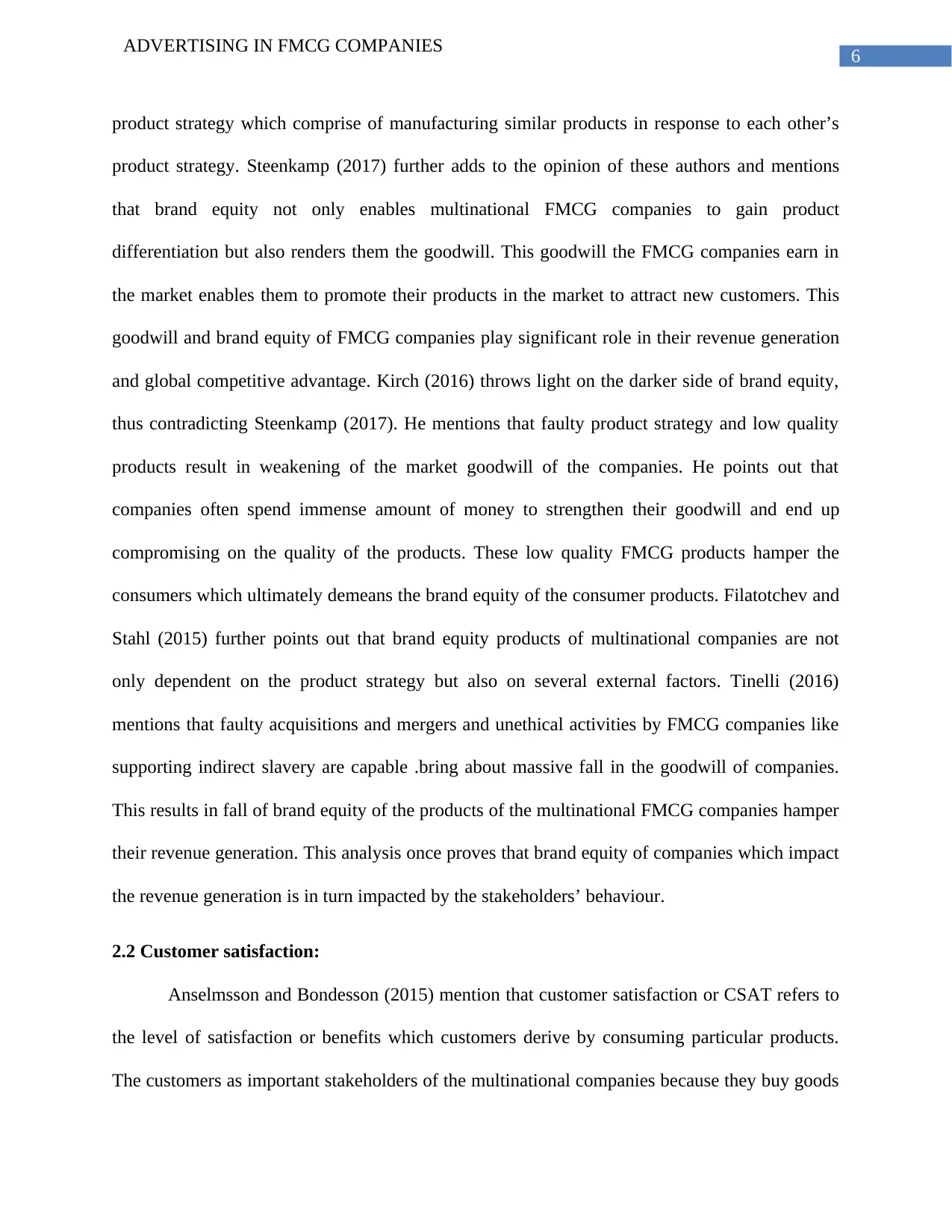
6
ADVERTISING IN FMCG COMPANIES
product strategy which comprise of manufacturing similar products in response to each other’s
product strategy. Steenkamp (2017) further adds to the opinion of these authors and mentions
that brand equity not only enables multinational FMCG companies to gain product
differentiation but also renders them the goodwill. This goodwill the FMCG companies earn in
the market enables them to promote their products in the market to attract new customers. This
goodwill and brand equity of FMCG companies play significant role in their revenue generation
and global competitive advantage. Kirch (2016) throws light on the darker side of brand equity,
thus contradicting Steenkamp (2017). He mentions that faulty product strategy and low quality
products result in weakening of the market goodwill of the companies. He points out that
companies often spend immense amount of money to strengthen their goodwill and end up
compromising on the quality of the products. These low quality FMCG products hamper the
consumers which ultimately demeans the brand equity of the consumer products. Filatotchev and
Stahl (2015) further points out that brand equity products of multinational companies are not
only dependent on the product strategy but also on several external factors. Tinelli (2016)
mentions that faulty acquisitions and mergers and unethical activities by FMCG companies like
supporting indirect slavery are capable .bring about massive fall in the goodwill of companies.
This results in fall of brand equity of the products of the multinational FMCG companies hamper
their revenue generation. This analysis once proves that brand equity of companies which impact
the revenue generation is in turn impacted by the stakeholders’ behaviour.
2.2 Customer satisfaction:
Anselmsson and Bondesson (2015) mention that customer satisfaction or CSAT refers to
the level of satisfaction or benefits which customers derive by consuming particular products.
The customers as important stakeholders of the multinational companies because they buy goods
ADVERTISING IN FMCG COMPANIES
product strategy which comprise of manufacturing similar products in response to each other’s
product strategy. Steenkamp (2017) further adds to the opinion of these authors and mentions
that brand equity not only enables multinational FMCG companies to gain product
differentiation but also renders them the goodwill. This goodwill the FMCG companies earn in
the market enables them to promote their products in the market to attract new customers. This
goodwill and brand equity of FMCG companies play significant role in their revenue generation
and global competitive advantage. Kirch (2016) throws light on the darker side of brand equity,
thus contradicting Steenkamp (2017). He mentions that faulty product strategy and low quality
products result in weakening of the market goodwill of the companies. He points out that
companies often spend immense amount of money to strengthen their goodwill and end up
compromising on the quality of the products. These low quality FMCG products hamper the
consumers which ultimately demeans the brand equity of the consumer products. Filatotchev and
Stahl (2015) further points out that brand equity products of multinational companies are not
only dependent on the product strategy but also on several external factors. Tinelli (2016)
mentions that faulty acquisitions and mergers and unethical activities by FMCG companies like
supporting indirect slavery are capable .bring about massive fall in the goodwill of companies.
This results in fall of brand equity of the products of the multinational FMCG companies hamper
their revenue generation. This analysis once proves that brand equity of companies which impact
the revenue generation is in turn impacted by the stakeholders’ behaviour.
2.2 Customer satisfaction:
Anselmsson and Bondesson (2015) mention that customer satisfaction or CSAT refers to
the level of satisfaction or benefits which customers derive by consuming particular products.
The customers as important stakeholders of the multinational companies because they buy goods
Paraphrase This Document
Need a fresh take? Get an instant paraphrase of this document with our AI Paraphraser
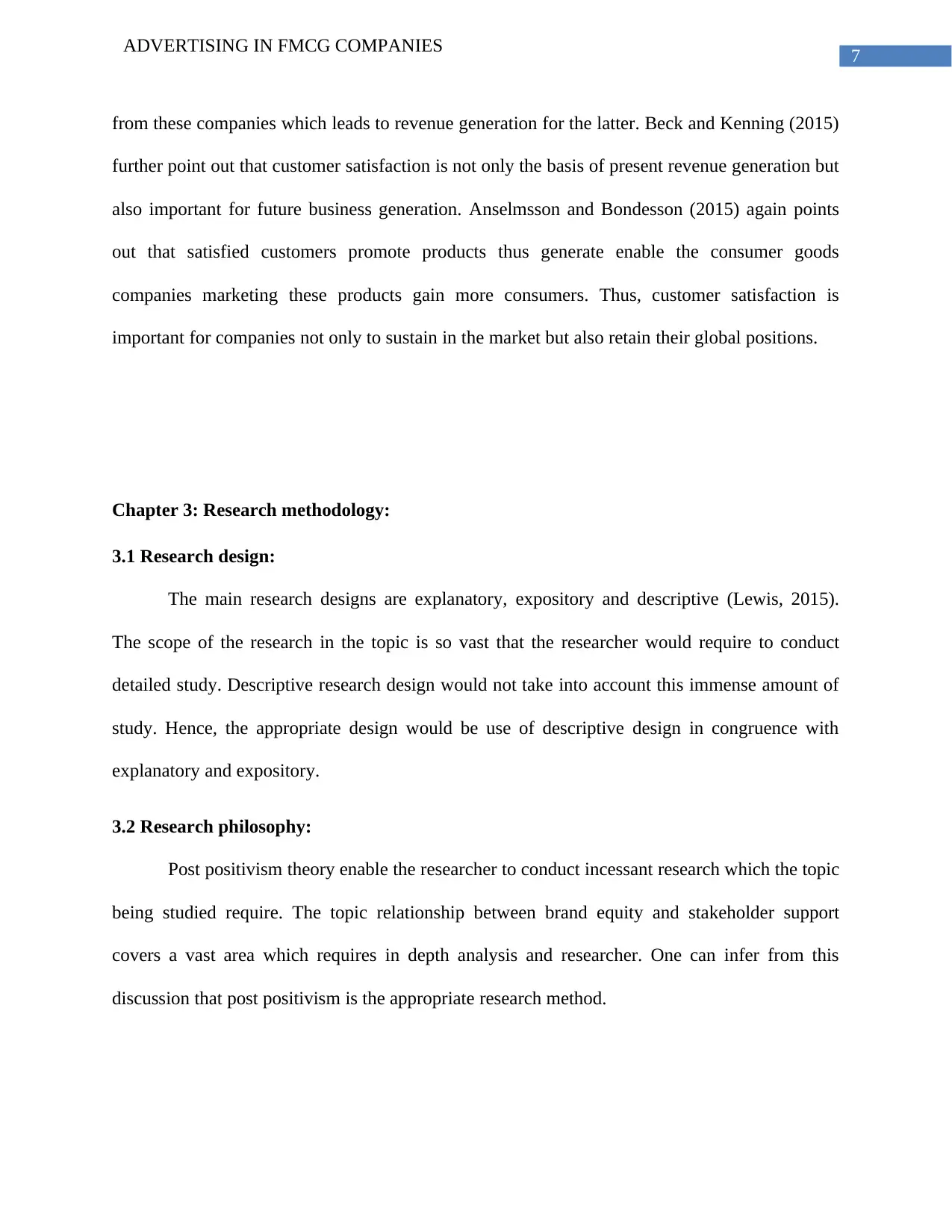
7
ADVERTISING IN FMCG COMPANIES
from these companies which leads to revenue generation for the latter. Beck and Kenning (2015)
further point out that customer satisfaction is not only the basis of present revenue generation but
also important for future business generation. Anselmsson and Bondesson (2015) again points
out that satisfied customers promote products thus generate enable the consumer goods
companies marketing these products gain more consumers. Thus, customer satisfaction is
important for companies not only to sustain in the market but also retain their global positions.
Chapter 3: Research methodology:
3.1 Research design:
The main research designs are explanatory, expository and descriptive (Lewis, 2015).
The scope of the research in the topic is so vast that the researcher would require to conduct
detailed study. Descriptive research design would not take into account this immense amount of
study. Hence, the appropriate design would be use of descriptive design in congruence with
explanatory and expository.
3.2 Research philosophy:
Post positivism theory enable the researcher to conduct incessant research which the topic
being studied require. The topic relationship between brand equity and stakeholder support
covers a vast area which requires in depth analysis and researcher. One can infer from this
discussion that post positivism is the appropriate research method.
ADVERTISING IN FMCG COMPANIES
from these companies which leads to revenue generation for the latter. Beck and Kenning (2015)
further point out that customer satisfaction is not only the basis of present revenue generation but
also important for future business generation. Anselmsson and Bondesson (2015) again points
out that satisfied customers promote products thus generate enable the consumer goods
companies marketing these products gain more consumers. Thus, customer satisfaction is
important for companies not only to sustain in the market but also retain their global positions.
Chapter 3: Research methodology:
3.1 Research design:
The main research designs are explanatory, expository and descriptive (Lewis, 2015).
The scope of the research in the topic is so vast that the researcher would require to conduct
detailed study. Descriptive research design would not take into account this immense amount of
study. Hence, the appropriate design would be use of descriptive design in congruence with
explanatory and expository.
3.2 Research philosophy:
Post positivism theory enable the researcher to conduct incessant research which the topic
being studied require. The topic relationship between brand equity and stakeholder support
covers a vast area which requires in depth analysis and researcher. One can infer from this
discussion that post positivism is the appropriate research method.
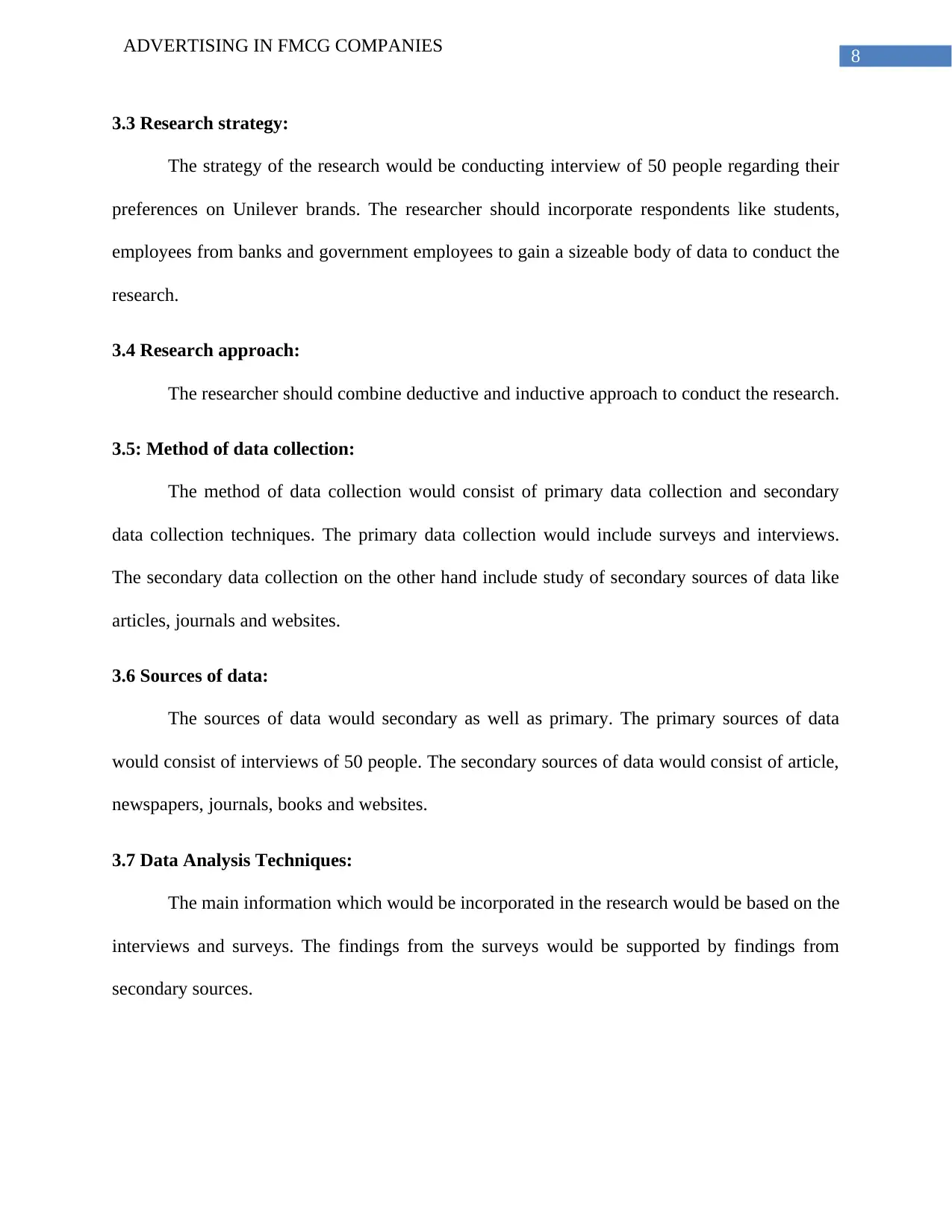
8
ADVERTISING IN FMCG COMPANIES
3.3 Research strategy:
The strategy of the research would be conducting interview of 50 people regarding their
preferences on Unilever brands. The researcher should incorporate respondents like students,
employees from banks and government employees to gain a sizeable body of data to conduct the
research.
3.4 Research approach:
The researcher should combine deductive and inductive approach to conduct the research.
3.5: Method of data collection:
The method of data collection would consist of primary data collection and secondary
data collection techniques. The primary data collection would include surveys and interviews.
The secondary data collection on the other hand include study of secondary sources of data like
articles, journals and websites.
3.6 Sources of data:
The sources of data would secondary as well as primary. The primary sources of data
would consist of interviews of 50 people. The secondary sources of data would consist of article,
newspapers, journals, books and websites.
3.7 Data Analysis Techniques:
The main information which would be incorporated in the research would be based on the
interviews and surveys. The findings from the surveys would be supported by findings from
secondary sources.
ADVERTISING IN FMCG COMPANIES
3.3 Research strategy:
The strategy of the research would be conducting interview of 50 people regarding their
preferences on Unilever brands. The researcher should incorporate respondents like students,
employees from banks and government employees to gain a sizeable body of data to conduct the
research.
3.4 Research approach:
The researcher should combine deductive and inductive approach to conduct the research.
3.5: Method of data collection:
The method of data collection would consist of primary data collection and secondary
data collection techniques. The primary data collection would include surveys and interviews.
The secondary data collection on the other hand include study of secondary sources of data like
articles, journals and websites.
3.6 Sources of data:
The sources of data would secondary as well as primary. The primary sources of data
would consist of interviews of 50 people. The secondary sources of data would consist of article,
newspapers, journals, books and websites.
3.7 Data Analysis Techniques:
The main information which would be incorporated in the research would be based on the
interviews and surveys. The findings from the surveys would be supported by findings from
secondary sources.
⊘ This is a preview!⊘
Do you want full access?
Subscribe today to unlock all pages.

Trusted by 1+ million students worldwide
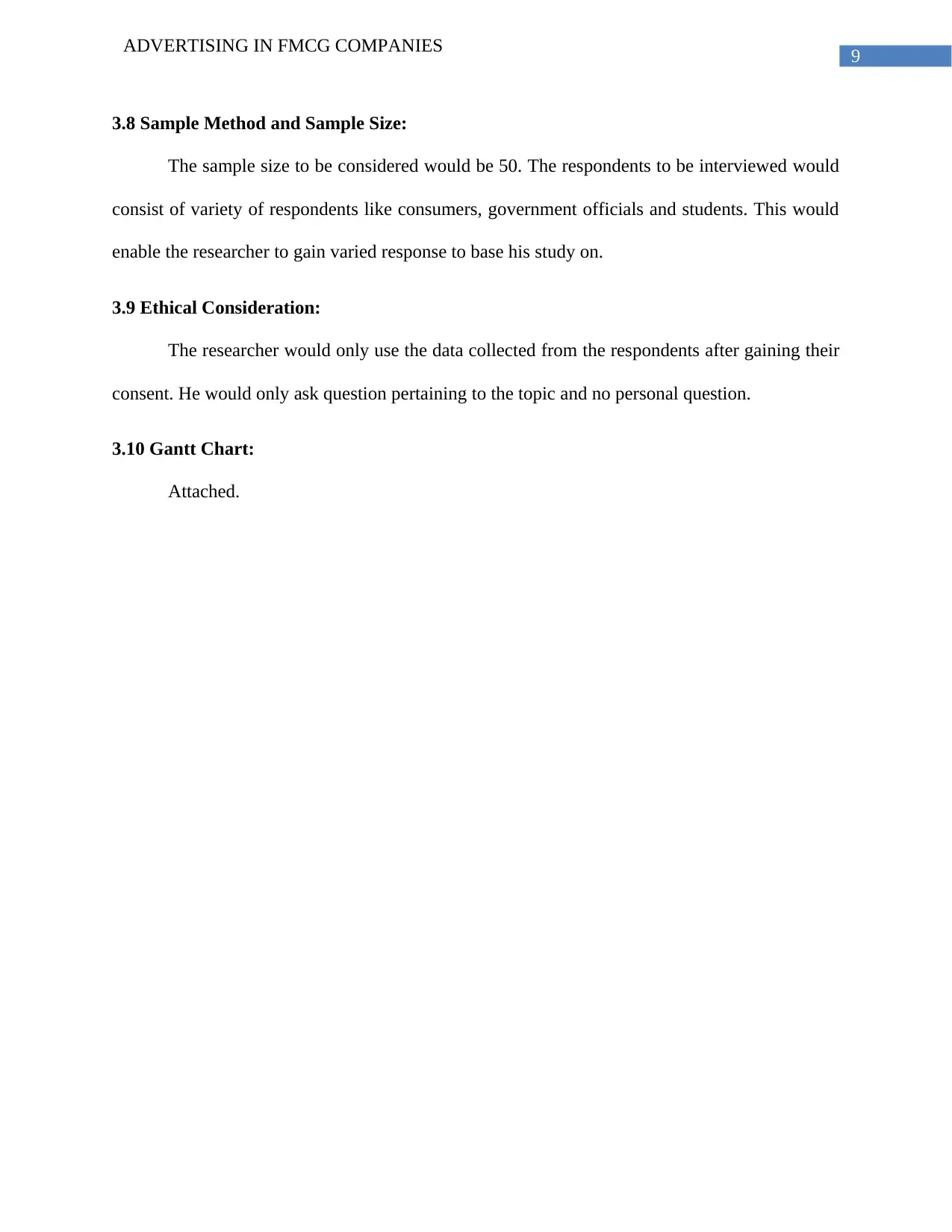
9
ADVERTISING IN FMCG COMPANIES
3.8 Sample Method and Sample Size:
The sample size to be considered would be 50. The respondents to be interviewed would
consist of variety of respondents like consumers, government officials and students. This would
enable the researcher to gain varied response to base his study on.
3.9 Ethical Consideration:
The researcher would only use the data collected from the respondents after gaining their
consent. He would only ask question pertaining to the topic and no personal question.
3.10 Gantt Chart:
Attached.
ADVERTISING IN FMCG COMPANIES
3.8 Sample Method and Sample Size:
The sample size to be considered would be 50. The respondents to be interviewed would
consist of variety of respondents like consumers, government officials and students. This would
enable the researcher to gain varied response to base his study on.
3.9 Ethical Consideration:
The researcher would only use the data collected from the respondents after gaining their
consent. He would only ask question pertaining to the topic and no personal question.
3.10 Gantt Chart:
Attached.
Paraphrase This Document
Need a fresh take? Get an instant paraphrase of this document with our AI Paraphraser
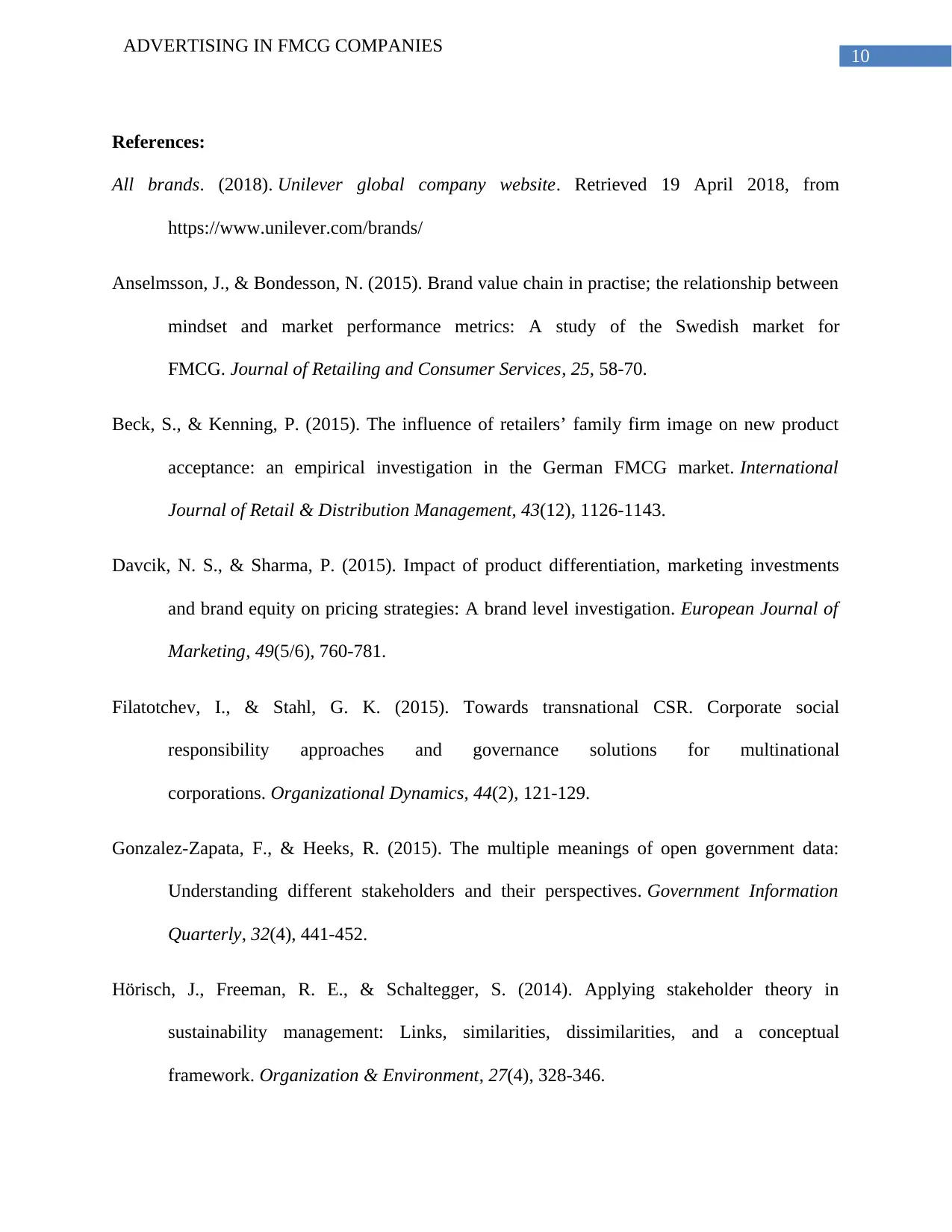
10
ADVERTISING IN FMCG COMPANIES
References:
All brands. (2018). Unilever global company website. Retrieved 19 April 2018, from
https://www.unilever.com/brands/
Anselmsson, J., & Bondesson, N. (2015). Brand value chain in practise; the relationship between
mindset and market performance metrics: A study of the Swedish market for
FMCG. Journal of Retailing and Consumer Services, 25, 58-70.
Beck, S., & Kenning, P. (2015). The influence of retailers’ family firm image on new product
acceptance: an empirical investigation in the German FMCG market. International
Journal of Retail & Distribution Management, 43(12), 1126-1143.
Davcik, N. S., & Sharma, P. (2015). Impact of product differentiation, marketing investments
and brand equity on pricing strategies: A brand level investigation. European Journal of
Marketing, 49(5/6), 760-781.
Filatotchev, I., & Stahl, G. K. (2015). Towards transnational CSR. Corporate social
responsibility approaches and governance solutions for multinational
corporations. Organizational Dynamics, 44(2), 121-129.
Gonzalez-Zapata, F., & Heeks, R. (2015). The multiple meanings of open government data:
Understanding different stakeholders and their perspectives. Government Information
Quarterly, 32(4), 441-452.
Hörisch, J., Freeman, R. E., & Schaltegger, S. (2014). Applying stakeholder theory in
sustainability management: Links, similarities, dissimilarities, and a conceptual
framework. Organization & Environment, 27(4), 328-346.
ADVERTISING IN FMCG COMPANIES
References:
All brands. (2018). Unilever global company website. Retrieved 19 April 2018, from
https://www.unilever.com/brands/
Anselmsson, J., & Bondesson, N. (2015). Brand value chain in practise; the relationship between
mindset and market performance metrics: A study of the Swedish market for
FMCG. Journal of Retailing and Consumer Services, 25, 58-70.
Beck, S., & Kenning, P. (2015). The influence of retailers’ family firm image on new product
acceptance: an empirical investigation in the German FMCG market. International
Journal of Retail & Distribution Management, 43(12), 1126-1143.
Davcik, N. S., & Sharma, P. (2015). Impact of product differentiation, marketing investments
and brand equity on pricing strategies: A brand level investigation. European Journal of
Marketing, 49(5/6), 760-781.
Filatotchev, I., & Stahl, G. K. (2015). Towards transnational CSR. Corporate social
responsibility approaches and governance solutions for multinational
corporations. Organizational Dynamics, 44(2), 121-129.
Gonzalez-Zapata, F., & Heeks, R. (2015). The multiple meanings of open government data:
Understanding different stakeholders and their perspectives. Government Information
Quarterly, 32(4), 441-452.
Hörisch, J., Freeman, R. E., & Schaltegger, S. (2014). Applying stakeholder theory in
sustainability management: Links, similarities, dissimilarities, and a conceptual
framework. Organization & Environment, 27(4), 328-346.
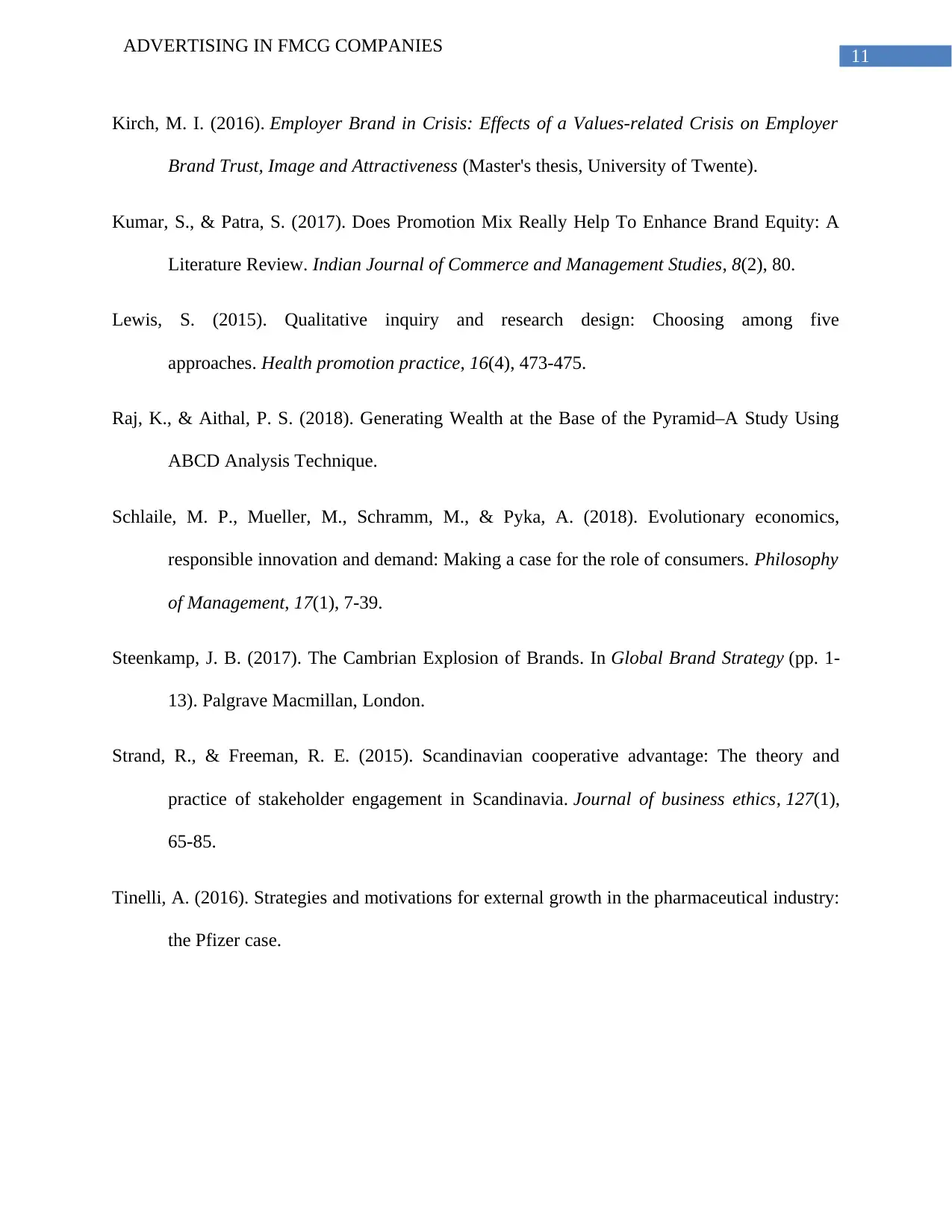
11
ADVERTISING IN FMCG COMPANIES
Kirch, M. I. (2016). Employer Brand in Crisis: Effects of a Values-related Crisis on Employer
Brand Trust, Image and Attractiveness (Master's thesis, University of Twente).
Kumar, S., & Patra, S. (2017). Does Promotion Mix Really Help To Enhance Brand Equity: A
Literature Review. Indian Journal of Commerce and Management Studies, 8(2), 80.
Lewis, S. (2015). Qualitative inquiry and research design: Choosing among five
approaches. Health promotion practice, 16(4), 473-475.
Raj, K., & Aithal, P. S. (2018). Generating Wealth at the Base of the Pyramid–A Study Using
ABCD Analysis Technique.
Schlaile, M. P., Mueller, M., Schramm, M., & Pyka, A. (2018). Evolutionary economics,
responsible innovation and demand: Making a case for the role of consumers. Philosophy
of Management, 17(1), 7-39.
Steenkamp, J. B. (2017). The Cambrian Explosion of Brands. In Global Brand Strategy (pp. 1-
13). Palgrave Macmillan, London.
Strand, R., & Freeman, R. E. (2015). Scandinavian cooperative advantage: The theory and
practice of stakeholder engagement in Scandinavia. Journal of business ethics, 127(1),
65-85.
Tinelli, A. (2016). Strategies and motivations for external growth in the pharmaceutical industry:
the Pfizer case.
ADVERTISING IN FMCG COMPANIES
Kirch, M. I. (2016). Employer Brand in Crisis: Effects of a Values-related Crisis on Employer
Brand Trust, Image and Attractiveness (Master's thesis, University of Twente).
Kumar, S., & Patra, S. (2017). Does Promotion Mix Really Help To Enhance Brand Equity: A
Literature Review. Indian Journal of Commerce and Management Studies, 8(2), 80.
Lewis, S. (2015). Qualitative inquiry and research design: Choosing among five
approaches. Health promotion practice, 16(4), 473-475.
Raj, K., & Aithal, P. S. (2018). Generating Wealth at the Base of the Pyramid–A Study Using
ABCD Analysis Technique.
Schlaile, M. P., Mueller, M., Schramm, M., & Pyka, A. (2018). Evolutionary economics,
responsible innovation and demand: Making a case for the role of consumers. Philosophy
of Management, 17(1), 7-39.
Steenkamp, J. B. (2017). The Cambrian Explosion of Brands. In Global Brand Strategy (pp. 1-
13). Palgrave Macmillan, London.
Strand, R., & Freeman, R. E. (2015). Scandinavian cooperative advantage: The theory and
practice of stakeholder engagement in Scandinavia. Journal of business ethics, 127(1),
65-85.
Tinelli, A. (2016). Strategies and motivations for external growth in the pharmaceutical industry:
the Pfizer case.
⊘ This is a preview!⊘
Do you want full access?
Subscribe today to unlock all pages.

Trusted by 1+ million students worldwide
1 out of 12
Related Documents
Your All-in-One AI-Powered Toolkit for Academic Success.
+13062052269
info@desklib.com
Available 24*7 on WhatsApp / Email
![[object Object]](/_next/static/media/star-bottom.7253800d.svg)
Unlock your academic potential
Copyright © 2020–2025 A2Z Services. All Rights Reserved. Developed and managed by ZUCOL.





